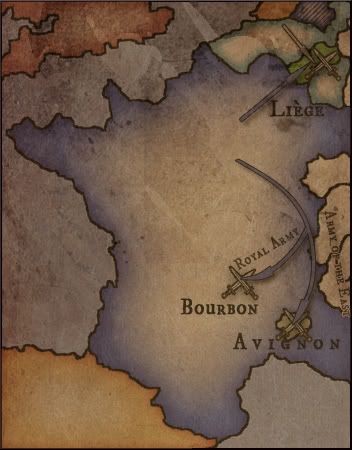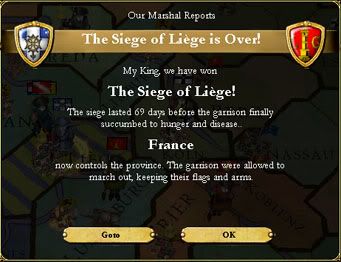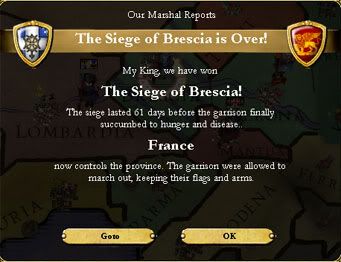Chapter XXII – All Roads Lead to Rome
“Let us forget these devilish words of deceit and fracture; Huguenot! Lutheran and Papist. But let us never forsake the name of Christian”
***
The Holy League Renewed
***
The effort needed to forge the fractured French society together after the bloody foreign and domestic wars proved to be harder than the triumvirate expected. Although Huguenot ministers now preached openly from Calais to Provence, certain rifts in society were hard to heal despite the religious uniformity. Especially the regional dissent in the newly acquired Southern Netherlands proved to be a constant cause to trouble for the local military governors. Uprisings regularly took place in Hainaut and Artois and often with support from Catholic guerrillas from Luxembourg and Flanders. These attacks and revolts were very firmly put down by the military, but, to the great disappointment of Paris, the populace continued to rise in defiance. This puzzled the triumvirate government extremely much, regular peasant uprisings usually only occurred once every generation, but these attacks were the work of something deeper. To the ministers in Paris, there had to be some sort of conspiracy brewing. Unsurprisingly Rohan moved to perform a domestic investigation of the Walloon insurrections. The inquiries and interrogations the Paris government instituted as a response to the Catholic and regionalist uprisings revealed a surprisingly stealthy organisation with ties to all the important Roman-Catholic thrones in Europe. This shadowy circle went under the frightening known catholic name, the Holy League. It was clear that the masterminds behind the plot were trying to draw as much authority out of the old league that had opposed Henri IV so vigorously. The fact that it had taken considerable efforts for Sully’s agents to discover this small piece of information already spelled trouble for the Huguenot cabinet. Even more worrying was the nature of the organisation’s helmsman. A true éminence grise the person was only known as the cardinal. Other than that the French spies knew that he controlled cords that ran out to Madrid, Vienna and Rome.
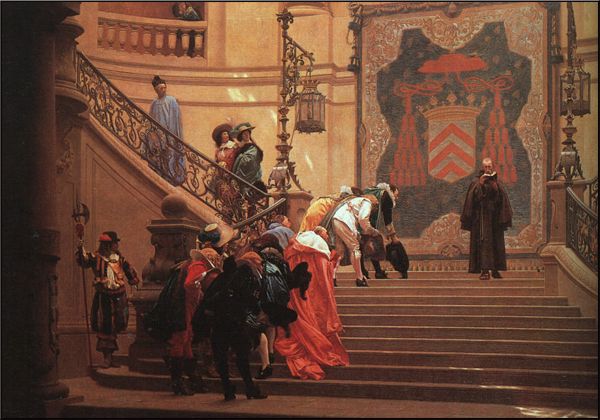
The Catholic international organisation was full of mysteries. Every clerk from monk and friar to bishop and cardinal could be a member.
By July 1616 the French government got into its possession disturbing information as documents found on arrested Spanish monks revealed the plan to remove the Huguenot governors in southern France and replace them with Catholic émigrés. The real problem wasn’t as much the fact that foreign monks served in the ranks of a domestic French opposition group, but rather that these clerks were caught as they tried to sneak into the papal enclave around Avignon. When the French guards made moves to stop them, they ran, as a Huguenot watchman noted; “..as fast as their legs could move under the dress.” Some of the suspects made it back into Avignon and when the French demanded them to be handed over, the Catholic commander responded by firing off warning shots from the fortress’ ramparts. The world was bracing itself for a confrontation between the reformers and the very fundament of the Catholic faith, Rome itself.
***
Papal Crown and Sceptre
***
The pope’s denial to handing over the remaining Spaniard conspirators provided the triumvirate with an excellent opportunity to remove two of the League’s supposed major strongholds; Avignon and Liége. The count-bishop of Liége was in alliance with the Pope and the two old clergymen had gathered a host of supporters, chief amongst them was Venice, around them. These two points of Catholic resistance were highly annoying to the Triumvirate. Just having a papal enclave within the very kingdom of France was a monstrosity; the recent scandal had proven that beyond any doubt, and the count-bishop of Liége had been known to give radical Catholic preachers shelter when they fled from the French authorities. However more solid proof was needed before the French triumvirate could justify outright war with the throne of St. Peter. Even though the regency had the support of the army, the people, the church and the nobility they still needed to tread softly[1]. Sully had his best men “treat” the captive Spanish friars enough to make them forge certain documents that highly compromised the papal role in the plans for a coup d’état in southern France.

Documents are forged.
When pope Innocent realised what way the wind was blowing he wasted no time on a diplomatic defence (which would have been slightly hypocritical as it was pretty clear that the Papal States had some financial and political ties to the League) but rallied his allies instead. He also sent pleas for help to the Habsburgs who had fought the Valois dynasty out of Italy years before, however, 1616 wasn’t 1559 and the Habsburg powers were a far cry away from Cateau-Cambrésis[2] and Marciano[3]. Furthermore Austria was deeply occupied with Bohemian revolts, where Protestants rose up in anger over the Catholic forced conversions and Spain was tumbling with intern problems as nobles schemed against their king Philip. The Pope couldn’t count on any support from the great Habsburg powers, but he still had a sizeable amount of Italian allies. The Grand Duchy of Tuscany, Mantua and the Republic of Venice all stood by the Holy Father and the prince-bishop of Liége.
Surprisingly, the Republic of Sicily announced that it would stand by the side of its Italian sister states in defence of the only true faith. Sully didn’t seem to mind the Sicilian exit as there was bad blood between himself and Sicilian council. This was mostly a result of the Peace of Antwerp where Sully had denied the Sicilians complete control over Spanish Naples after the war.
Yet the rest of the Reformed Alliance eagerly joined the fight against the papists. Soon English, French, Walloon, Dutch and German soldiers would march the roads to Rome.
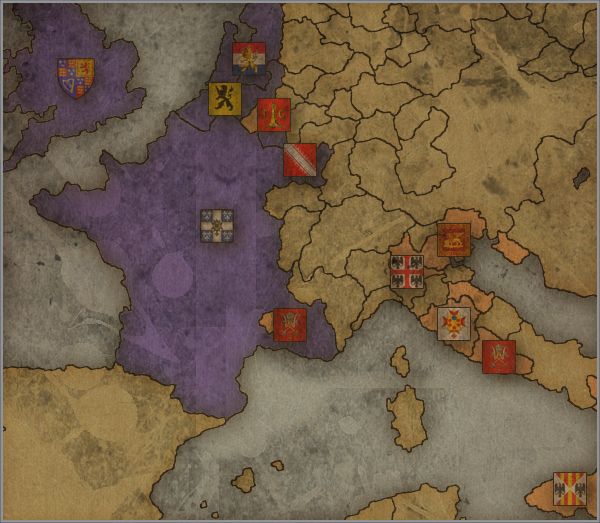
Sides are chosen
[1]I think it’s excusable for the marshals to be able to declare war, as they hold almost absolute powers within the kingdom, plus they have solid support from England-Scotland and Flanders.
[2] Treaty that humiliated France after the Italian War between Henri II Valois and Charles V Habsburg .
[3] Battle during said Italian War.
“Let us forget these devilish words of deceit and fracture; Huguenot! Lutheran and Papist. But let us never forsake the name of Christian”
***
The Holy League Renewed
***
The effort needed to forge the fractured French society together after the bloody foreign and domestic wars proved to be harder than the triumvirate expected. Although Huguenot ministers now preached openly from Calais to Provence, certain rifts in society were hard to heal despite the religious uniformity. Especially the regional dissent in the newly acquired Southern Netherlands proved to be a constant cause to trouble for the local military governors. Uprisings regularly took place in Hainaut and Artois and often with support from Catholic guerrillas from Luxembourg and Flanders. These attacks and revolts were very firmly put down by the military, but, to the great disappointment of Paris, the populace continued to rise in defiance. This puzzled the triumvirate government extremely much, regular peasant uprisings usually only occurred once every generation, but these attacks were the work of something deeper. To the ministers in Paris, there had to be some sort of conspiracy brewing. Unsurprisingly Rohan moved to perform a domestic investigation of the Walloon insurrections. The inquiries and interrogations the Paris government instituted as a response to the Catholic and regionalist uprisings revealed a surprisingly stealthy organisation with ties to all the important Roman-Catholic thrones in Europe. This shadowy circle went under the frightening known catholic name, the Holy League. It was clear that the masterminds behind the plot were trying to draw as much authority out of the old league that had opposed Henri IV so vigorously. The fact that it had taken considerable efforts for Sully’s agents to discover this small piece of information already spelled trouble for the Huguenot cabinet. Even more worrying was the nature of the organisation’s helmsman. A true éminence grise the person was only known as the cardinal. Other than that the French spies knew that he controlled cords that ran out to Madrid, Vienna and Rome.

The Catholic international organisation was full of mysteries. Every clerk from monk and friar to bishop and cardinal could be a member.
By July 1616 the French government got into its possession disturbing information as documents found on arrested Spanish monks revealed the plan to remove the Huguenot governors in southern France and replace them with Catholic émigrés. The real problem wasn’t as much the fact that foreign monks served in the ranks of a domestic French opposition group, but rather that these clerks were caught as they tried to sneak into the papal enclave around Avignon. When the French guards made moves to stop them, they ran, as a Huguenot watchman noted; “..as fast as their legs could move under the dress.” Some of the suspects made it back into Avignon and when the French demanded them to be handed over, the Catholic commander responded by firing off warning shots from the fortress’ ramparts. The world was bracing itself for a confrontation between the reformers and the very fundament of the Catholic faith, Rome itself.
***
Papal Crown and Sceptre
***
The pope’s denial to handing over the remaining Spaniard conspirators provided the triumvirate with an excellent opportunity to remove two of the League’s supposed major strongholds; Avignon and Liége. The count-bishop of Liége was in alliance with the Pope and the two old clergymen had gathered a host of supporters, chief amongst them was Venice, around them. These two points of Catholic resistance were highly annoying to the Triumvirate. Just having a papal enclave within the very kingdom of France was a monstrosity; the recent scandal had proven that beyond any doubt, and the count-bishop of Liége had been known to give radical Catholic preachers shelter when they fled from the French authorities. However more solid proof was needed before the French triumvirate could justify outright war with the throne of St. Peter. Even though the regency had the support of the army, the people, the church and the nobility they still needed to tread softly[1]. Sully had his best men “treat” the captive Spanish friars enough to make them forge certain documents that highly compromised the papal role in the plans for a coup d’état in southern France.

Documents are forged.
When pope Innocent realised what way the wind was blowing he wasted no time on a diplomatic defence (which would have been slightly hypocritical as it was pretty clear that the Papal States had some financial and political ties to the League) but rallied his allies instead. He also sent pleas for help to the Habsburgs who had fought the Valois dynasty out of Italy years before, however, 1616 wasn’t 1559 and the Habsburg powers were a far cry away from Cateau-Cambrésis[2] and Marciano[3]. Furthermore Austria was deeply occupied with Bohemian revolts, where Protestants rose up in anger over the Catholic forced conversions and Spain was tumbling with intern problems as nobles schemed against their king Philip. The Pope couldn’t count on any support from the great Habsburg powers, but he still had a sizeable amount of Italian allies. The Grand Duchy of Tuscany, Mantua and the Republic of Venice all stood by the Holy Father and the prince-bishop of Liége.
Surprisingly, the Republic of Sicily announced that it would stand by the side of its Italian sister states in defence of the only true faith. Sully didn’t seem to mind the Sicilian exit as there was bad blood between himself and Sicilian council. This was mostly a result of the Peace of Antwerp where Sully had denied the Sicilians complete control over Spanish Naples after the war.
Yet the rest of the Reformed Alliance eagerly joined the fight against the papists. Soon English, French, Walloon, Dutch and German soldiers would march the roads to Rome.

Sides are chosen
[1]I think it’s excusable for the marshals to be able to declare war, as they hold almost absolute powers within the kingdom, plus they have solid support from England-Scotland and Flanders.
[2] Treaty that humiliated France after the Italian War between Henri II Valois and Charles V Habsburg .
[3] Battle during said Italian War.



